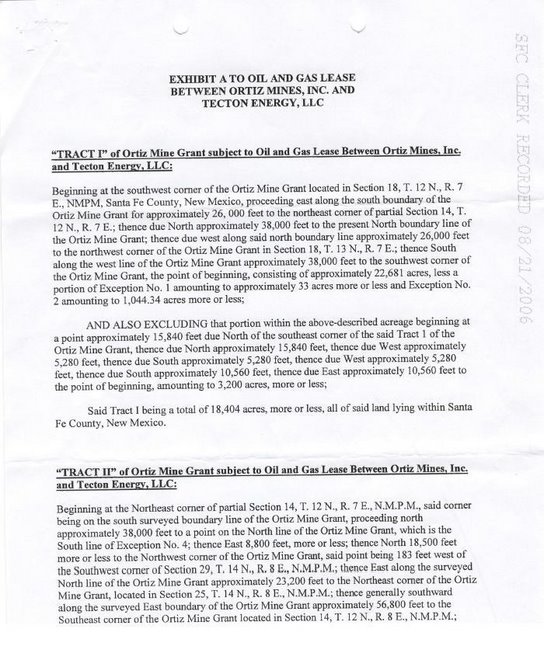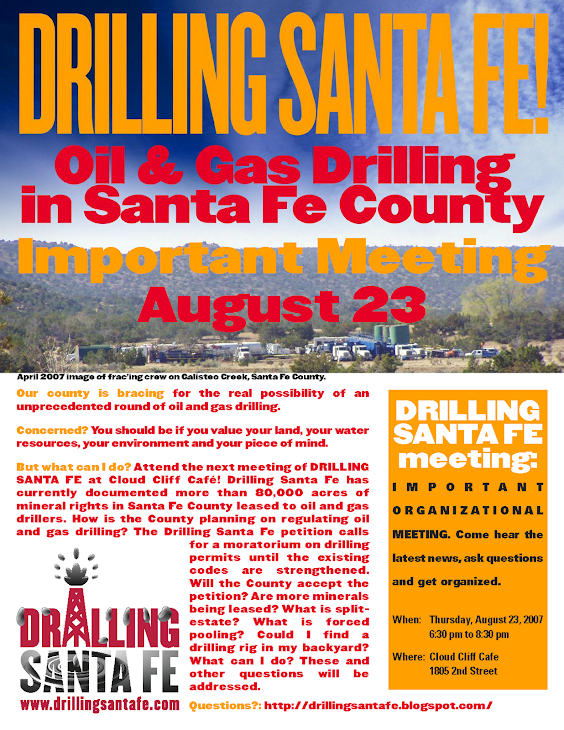|
"All but one county in New Mexico relies on state rules to regulate oil and gas drilling. (Not accurate. Mischaracterizes the Santa Fe County Oil and Gas Ordinance.)
That county? None other than Santa Fe County. Neighboring Rio Arriba County is considering an ordinance to further restrict oil and gas drilling. (Rio Arriba County has an oil and gas ordinance.)
Here’s a little history on the stricter local regulations. Houston-based Tecton Energy bought (leased) 65,000 acres of mineral rights in the Galisteo basin from which to pull oil and gas. When Tecton started drilling for oil and gasoline in the fall of 2007, Santa Fe County officials put the kibosh on the idea (re-entered Black-Ferrill #1). County commissioners enacted a three-month moratorium on drilling until they could figure out how to control it. After the moratorium passed, Tecton pulled out and its lease expired. (Not accurate.)
“It was an unusual event,” said Chris Fling, a partner in Tecton. “The citizens lost a lot: job opportunities, revenue.” (Not accurate.)
He described the state and Santa Fe County as “politicized” regulators. Fling said he wishes Santa Fe County and the state would base their actions about oil and gas drilling on data, not emotion. Because they do not, he said, Tecton will not return to New Mexico anytime soon to drill.
Oil and gas ordinance
After the moratorium, commissioners passed an oil and gas ordinance in December 2008. “The county ordinance has (a) comprehensive set of environmental regulations which should render drilling as safe as it can be, given the tremendous forces inherent in the activity,” County Attorney Stephen Ross said. “That being said, we believe that drilling can be accomplished economically even given the requirements of the ordinance.” Commissioner Mike Anaya, who initiated the idea for the moratorium, did not reply to two e-mailed requests for comments for this article. His legislative liaison referred the questions to county spokesman Stephen Ulibarri. Commissioners wanted to regulate — not ban — oil and gas drilling, Ulibarri said. “You cannot prohibit oil and gas drilling,” he said. But you can make it difficult. The county’s ordinance requires eight reports or assessments be done by companies that want to drill here: A report that shows that what you’re planning to do is consistent with the county’s general plan. An environmental impact report. A fiscal impact report. A report that shows county facilities are sufficient to service oil and gas projects. Water availability assessment. In other words, how is the oil and gas drilling going to affect fresh water and subsurface water. A report that shows how easily your drilling might cause an emergency. Traffic report. Geohydrologic report.
Bob Gallagher, president of the New Mexico Oil and Gas Association, sees the county’s ordinance as a virtual ban on drilling. “The Santa Fe County ordinance, which I refer to as a moratorium, is by design, and with its $1 million price tag, the toughest in the United States,” he said. “It has assured that Santa Fe County, its residents, hospitals, schools and governments will never see a penny of income from oil and gas.” At the same time, it has stripped the property rights of private individuals, which ought to open up the eyes of others who have non-oil and gas property rights, once the nose of the camel is under the tent, he said. “There is no comparison to other New Mexico counties or even to the state regs,” Gallagher said. “The very few who have them were completed utilizing sound science and common sense.” | 



























